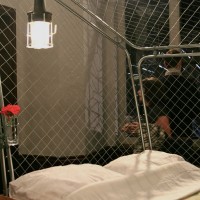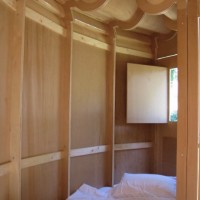Installations
Horizon Pavilion
The Horizon Pavilion is an attempt to invoke the open, tranquil, Dutch flatland in the busy city of London. Entering the pavilion through a doorway, one enters a corridor-like structure of open metal frames which twist and widen to towards a large window. The large reflective surfaces of the window obscure most of the street view leaving just a narrow horizontal strip. The mirrors above and below this reflect the sky and give the illusion of a wide Dutch horizon: just water, land and cloudy sky.
Are you in or are you out?
The way people claim and use spaces is intriguing. By creating a border, space is defined and given a name and purpose. Both in the private and the public realm these borders define our spatial experience. Are in you or are you out? crosses boundaries by being a physical transition between one place and another. It’s a Tent trailer for the great outdoors, but with a twist. It addresses a strange paradox:
Why do many go out to the countryside and bring a fenced off miniature version of their home comforts? Why do people need the safety of home when going outdoors? Doors, walls or fences are used to define the border between inside and outside, city versus countryside, public versus private, yours versus mine. They imply a culture and feeling of belonging that often accompanies these (invisible) lines. Are you in or are you out? is an effort to make people more conscious of the space they choose to be in and how they interact with it.
Frisian Sea
Where once the Zuiderzee posed a threat to the vilages lying on its coast, now a lot of it is just polders behind a useless dike.
This architectural installation makes passers by experience this history. A huge wave overhangs the dike. Visitors can ‘ride the wave’ by climbing a stairs to it’s top. There a small room is made where passers by can spend the night in its interior overlooking the land behind the dike.
Rendered images:
The Guardian, the Sleeper and the Dreamer
Three dikes named Guardian, Sleeper and Dreamer after there function in the landscape, are visually challenging the extreme tidal flow of the Loire-river and therefor emphasise a relation between the Dutch man-made landscape and it’s French opponent. Each dike contains a functional element for the campsite. The visitor can wake up under the shower of the Guardian (Dutch trans: the one who awakes). A bed is placed in the Sleeper. Finally one can sit and dream on the toilet in the Dreamer. Assignment by Estuaire Biennale, Nantes, France for autonomous design of a hide-out on an architecture campsite near the Loire river.
model scale 1:50
WindLight Pavilion
This pavilion functions like a sort of sundial. It shows the movements of the sunlight and the wind on one day and makes it into something to experience through an architectural space.
The entire structure of the facade can rotate due to the wind on its arms. One can enter the space by walking along to its rotation. When inside a small glasshouse made of photo-luminescent material catches the sunbeams coming through the openings in the facade. Because of the rotation combined with the beams of light, a ribbon of luminance raps around the glass house, showing the rhythm and strength of the elements: light and wind.
Rendered images of design:
Dream of a Closet
Dream of a Closet is an upscaled closet that one can sleep in. Based on an 17th century, Dutch ‘kuif-kast’ the shape is reinterpreted and enlarged to form an entire room.





























